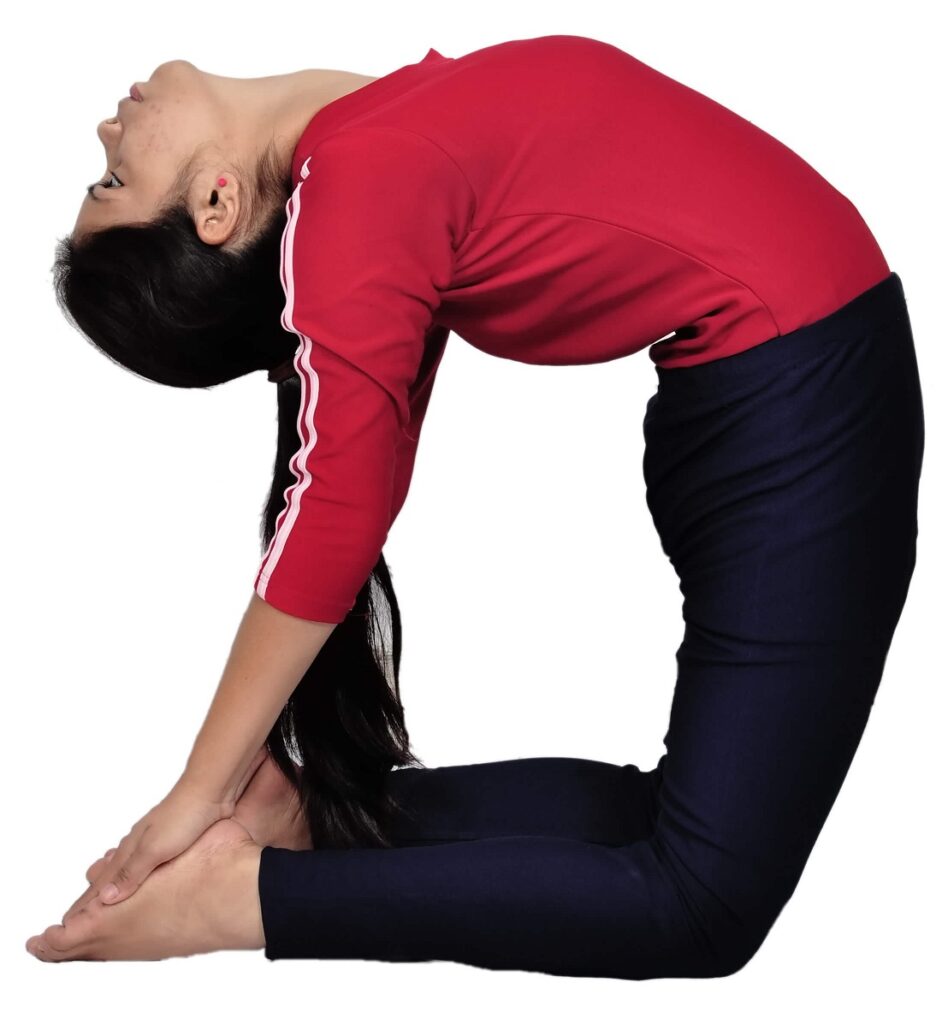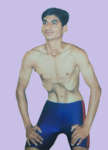Meaning of Camel pose
- Camel pose is also known as Ustrasana.
- Ustrasana is a Sanskrit word.
- Ustrasana is pronounced as ‘oosh-TRAHS-anna’.
- Ustra means ‘camel’, and asana means ‘yoga pose’.
- The thighs, trunk, and head resemble the camel, hence the Camel pose.
What is a Camel pose-Ustrasana?
- Camel pose is one of the important sitting yoga poses.
- It is called a Camel pose because it resembles a camel.
- It works well on nerves, the spine, and muscles of the back, chest, neck, and hips.
- The pose is helpful in the prevention and treatment of respiratory diseases, diabetes, thyroid and back pain.
- Considering the conditions of the COVID-19 pandemic, it is an important yoga pose to strengthen the respiratory system and enhance body immunity.

Camel pose introduction
The article has systematically described what it is, how to do it, and its benefits and precautions. All these aspects have been elaborated and mentioned after doing in-depth research on Ustrasana. The easily explained steps, benefits, precautions, images, and videos of Camel pose-Ustrasana will help you understand the yoga pose technically correctly, thereby extracting maximum benefits from it.
How to do camel pose-Ustrasana step-by-step
The simple way of performing the Ustrasana yoga pose is given below. Its more straightforward step-by-step technique has been mentioned below.
- Adjust the knees and feet to separate them by the same width as the hips.
- The feet should rest on the ground.
- Lean backwards slightly.
- Now, turn to the right side and grasp the right heel with the right hand and the left heel with the left hand.
- Allow the head to hang backwards.
- Try to relax the whole body, especially the back muscles.
- Push the body forward.
- Maintain the pose as long as you can.
- Do breathing slowly and deeply while holding the yoga pose.
- This is the one round.
- Do 2-3 rounds.
Camel pose learning information video
- The video of Ustrasana has been made very simple and easy to help understand the practitioners.
- It has been developed after a discussion with many yoga experts and teachers.
- Extensive research has also been carried out while making the video.
- It is a learning cum informational video that will help you to harness its benefits.
Video Courtesy: Morarji Desai National Institute of Yoga
Breathing awareness and duration
Breathing awareness plays a vital role while practising the camel pose. Ustrasana benefits increase manifolds if breathing synchronises between the body and mind while practising the yoga pose. One should inhale while bending backwards. Do slow inhaling and exhaling while maintaining the posture. Exhale, could you come to the original position? Initially, it should be held for 20-30 seconds. Increase the duration gradually as per one’s comfort and convenience.
Muscular movement
Muscles, which are experiencing movements, are the back, legs, hips, abdomen, chest, thighs, arms, and the muscles of the neck region. The chest muscles are experiencing maximum stretching. The muscles which are experiencing stretching, i.e. Trapezius, Psoas major, Rectus femoris, Vastus lateralis, Hamstrings, Sternocleidomastoid, Deltoid, Pectoralis major, Rectus abdominis, Apex of the lung, and Pectoralis minor.
Camel pose in different schools of Yoga
Ustrasana has some variations in steps and techniques while performed by renowned yoga experts and teachers. These different techniques by different schools of Yoga while practising Ustrasana are given below
- Iyengar yoga: The palms are on the sole instead of the heels.
- Vinyasa Yoga: It is the same as the technique mentioned above.
- Ashtanga Yoga: It is the same as the technique mentioned above.
- Baba Ramdev yoga: It is similar to the technique mentioned above.
- Art of living: It is similar to vinyasa yoga.
- Power yoga: The Main focus is on stretching and rigour of posture rigour.
- Hot yoga: It is similar to power yoga but more strenuous.
- Satyananda yoga: Here, the entire body is uplifted and rested upon soles and palms.
- Bikram yoga: It is similar to Iyengar yoga.
10 health benefits of Camel pose-Ustrasana
Some of the essential benefits of Ustrasana are given below.
- Flat stomach: The pose suits a flat stomach. This is also good for weight loss. For burning belly fat, one has to maintain the posture for a specific time and simultaneously experience the stretch on the abdominal region.
- Respiratory congestion: Practicing the yoga pose helps relieve and treat various respiratory-related problems. It helps to open the bronchia and alveoli and also increases their area. The yoga pose helps expand your chest and thoracic region, thus helping in immunity.
- Deeper breathing: Ustrasana helps expand the rib cage and ensures the enlargement of the breathing area.
- Thyroid prevention: It helps manage the thyroid by massaging the thyroid gland and releasing the thyroxin hormone. While practising soothing massage, it needs to be experienced by the practitioners.
- Spine strengthening: It provides adequate stretching to the entire spinal region and, accordingly, to the nerves and muscles.
- Rounded shoulders: The practice of the yoga pose helps to correct the rounded shoulders.
- Chest expansion: This is one of the best yoga poses to be practised for chest expansion. Doing this not only opens the chest but removes many respiratory blockages.
- Diabetes prevention: It gives adequate stretch to the chest and massages the pancreas, which in turn stirs the release of insulin hormone. Thus, it is beneficial for the treatment and management of blood sugar.
- Back pain: For patients with back and neck pain, it should be practised under the guidance of a yoga therapist.
- Thighs health: It incredibly stretches the thigh’s muscles and nerves.
Ustrasana precautions
Some of the few contraindications/cautions/limitations of the camel pose are:
- Severe back pain
- Lumbago
- Enlarged thyroid
- Hernia
- Heart disease
- High blood pressure
- Low blood pressure
- Abdominal injury
- Neck injury
Beginner’s tip
Stiff-back people should avoid this asana initially. The practice of this yoga pose requires adequate flexibility. Therefore, in the initial stage, one should perform Ardha Ustrasana. After acquiring for a few days and gaining certain flexibility and stamina, it is better to go ahead with Ustrasana and Purna Ustrasana. However, could you do it for 10-15 seconds while performing in the first stage?
Camel pose- Ustrasana sequence
Preparatory pose
- Tadasana
- Stickasana
- Ardhaustrasana
- Ardha Chakrasana

Follow-up / counterpose
- Paschimottasana
- Pawanmuktasana
- Janusirsasana
Top 10 facts about camel pose
There are some tips and points which need to be taken into consideration while performing this yoga pose.
- It is one of the essential asanas for dropping shoulders and hunched back.
- Adjust the knees and feet to separate them by the same width as the hips. This ensures firmness and balance.
- The body’s weight shouldn’t be on the arms and heels as it reduces the efficacy of the pose.
- Back muscles should be as relaxed as possible.
- Avoid too deep breathing in the final pose.
- The chest should be lifted.
- Hips should be pushed out.
- The neck should be relaxed in the final pose.
- The tailbone should be slightly forward.
- Shoulders should be drawn together.
The science behind camel pose-Ustrasana
The asana requires greater flexibility. Considering the anatomy and physiology of the pose, one can increase its benefits manifolds if it performs technically correctly. The muscles which are prominently involved during the practice of the asana are the Psoas major, Rectus femoris, Vastuslateralis, Hamstrings, Trapezius, Sternocleidomastoid, Deltoid, Pectoralis Major, Rectus abdominis, Apex of the lung, and Pectoralis minor. The camel pose gives new life to the breathing system, especially the lungs.
Modification and variations
- Ardhaustrasana
- Purnaustrasana







I just added this feed to my bookmarks. I enjoy reading your posts. Thank you!
Ive been meaning to publish about something like this on my website and this gave me an idea. Exactly the stuff I needed.
It’s rare to come across a blog that consistently delivers high-quality content, but that’s exactly what this blog does. The author’s writing is engaging and thought-provoking, and their commitment to providing well-researched and balanced perspectives is truly commendable.
I was blown away by the quality of this article. The author’s writing is not only informative and engaging, but also deeply thoughtful and insightful. I appreciate the level of research that went into each section, and the author’s ability to present complex information in a clear and accessible way. What I love most about this article is its commitment to presenting balanced and unbiased perspectives on a range of topics, which is increasingly rare in today’s media landscape. Overall, this article is a testament to the power of journalism to inform and educate readers.